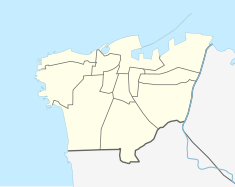Petit Serail
| Petit Serail | |
|---|---|
| Native name السراي الصغير | |

The Petit Serail
|
|
| Location | Beirut, Lebanon |
| Coordinates | 33°53′49″N 35°30′26″E / 33.896991°N 35.507331°ECoordinates: 33°53′49″N 35°30′26″E / 33.896991°N 35.507331°E |
| Built | 1881 |
| Built for | Ottoman administration |
| Architect | Bechara Effendi, Youssef Khayat |
| Architectural style(s) | Ottoman new order |
The Petit Serail (Arabic: السراي الصغير / ALA-LC: as-sarāy as- ṣaghir; literally "Little Saray"); was a historic administrative Ottoman building that housed the seat of the Wali of Syria and Beirut. It was situated to the northern side of Martyrs' Square at the heart of the Beirut Central District. The building was the scene of important historical events, but plans to enlarge Beirut's main square led to its destruction in 1950. It was one of several Ottoman era building projects that shaped the architecture of Lebanon in Beirut.
Inaugurated in 1884, the Petit Serail was the seat of Beirut’s governor general in 1888 and hosted the Lebanese government and president during the French Mandate. Demolished in 1950, its foundations were uncovered and preserved in the mid-1990s.
In the later half of the nineteenth century, the Beiruti authorities thought to move the seat of governorship from the decaying Emir Assaf saray also called Dar al-Wilaya (House of the Vilayet). The medieval structure was built in 1572 by Mohammad Assaf, the son of the Turkmen Emir Mansour Assaf.
On 11 September 1840, the British fleet bombarded Beirut to evacuate Ibrahim Pasha's troops from the city and damaged the old saray in the process. The saray was restored in 1843 by the wali of Beirut Assaad Mukhles Pasha.
In 1882 the board of administration of the Sanjak of Beirut decided to build a new administrative building and put up the Emir Assaf Saray for auction. The saray was sold in April 1882 to Mohammad Ayyas and then to members of the Sursock and Tueini families. The old saray was destroyed and replaced by the Sursock souks while work was underway on the construction of the new saray which will become known as the "Petit Serail" to differentiate it from the Kışla-i Humayun (the Ottoman barracks) which is better known as the Grand Serail.
...
Wikipedia

